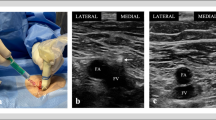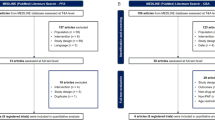Abstract
Purpose
Catheter ablation for supraventricular tachycardia (SVT) in adults with congenital heart disease (ACHD) is an important therapeutic option. Cavo-tricuspid isthmus (CTI)-dependent intraatrial re-entrant tachycardia (IART) is common. However, induction of sustained tachycardia at the time of ablation is not always possible. We hypothesised that performing an empiric CTI line in case of non-inducibility leads to good outcomes. Long-term outcomes of empiric versus entrained CTI ablation in ACHD patients were examined.
Methods
Retrospective, single-centre, case-control study over 7 years. Arrhythmia-free survival after empiric versus entrained CTI ablation was compared.
Results
Eighty-seven CTI ablations were performed in 85 ACHD patients between 2010 and 2017. The mean age of the cohort was 43 years and 48% were male. Underlying aetiology included ASD (31%), VSD (11.4%), AVSD (9.1%), AVR (4.8%), Fallot’s (18.4%), Ebstein’s (2.3%), Fontan’s palliation (9.2%) and atrial switch (13.8%). CTI-dependent IART was entrained in 59 patients whereas it was non-inducible in 28. The latter had an empiric CTI ablation. Forty-three percent of procedures were performed under general anaesthesia. There were no reported procedural complications. There was no significant difference in the mean procedure or fluoroscopy times between the groups (empiric vs entrained CTI; 169.1 vs 183.3 and 28.1 vs 19.9 min). Arrhythmia-free survival was 64.3% versus 72.8% (p value 0.44) in the empiric and entrained groups at 21 months follow-up.
Conclusions
Long-term outcomes after empiric and entrained CTI ablation for IART in ACHD patients are comparable. This is a safe and effective therapeutic option. In the case of non-inducibility of IART, an empiric CTI line should be considered in this cohort.



Similar content being viewed by others
References
Gewillig M, Cullen S, Mertens B, Lesaffre E, Deanfield J. Risk factors for arrhythmia and death after Mustard operation for simple transposition of the great arteries. Circulation. 1991;84(5 suppl):III187–92.
Gelatt M, Hamilton RM, McCrindle BW, Connelly M, Davis A, Harris L, et al. Arrhythmia and mortality after the Mustard procedure: a 30-year single-center experience. J Am Coll Cardiol. 1997;29:194–01.
Gatzoulis MA. Adult congenital heart disease: education, education, education. Nat Clin Pract Cardiovasc Med. 2006;3:2–3.
Deal BJ, Mavroudis C, Backer CL. Arrhythmia management in the Fontan patient. Pediatr Cardiol. 2007;28:448–56.
Wasmer K, Eckardt L. Management of supraventricular arrhythmias in adults with congenital heart disease. Heart. 2016;102(20):1614–9.
Walsh EP. Arrhythmias in patients with congenital heart disease. Card Electrophysiol Rev. 2002;6:422–30.
Garson A Jr, Bink-Boelkens M, Hesslein PS, Hordof AJ, Keane JF, Neches WH, et al. Atrial flutter in the young: a collaborative study of 380 cases. J Am Coll Cardiol. 1985;6:871–8.
van Hare GF. Radiofrequency ablation of accessory pathways associated with congenital heart disease. Pacing Clin Electrophysiol. 1997;20:2077–81.
Tanner H, Lukac P, Schwick N, Fuhrer J, Pedersen AK, Hansen PS, et al. Irrigated-tip catheter ablation of intraatrial reentrant tachycardia in patients late after surgery of congenital heart disease. Heart Rhythm. 2004;1:268–75.
Mah DY, Alexander ME, Cecchin F, Walsh EP, Triedman JK. The electroanatomic mechanisms of atrial tachycardia in patients with tetralogy of Fallot and double outlet right ventricle. J Cardiovasc Electrophysiol. 2011 Sep;22(9):1013–7.
Lobo RG, Griffith M, De Bono J. Ablation of arrhythmias in patients with adult congenital heart disease. Arrhythmia Electrophysiol Rev. 2014;3(1):36–9.
Ávila P, Mercier LA, Dore A, Marcotte F, Mongeon FP, Ibrahim R, et al. Adult congenital heart disease: a growing epidemic. Can J Cardiol. 2014;30:S410–9.
Somerville J. Management of adults with congenital heart disease: an increasing problem. Annu Rev Med. 1997;48:283–93.
Bouchardy J, Therrien J, Pilote L, Ionescu-Ittu R, Martucci G, Bottega N, et al. Atrial arrhythmias in adults with congenital heart disease. Circulation. 2009;120:1679–86.
Walsh EP. Interventional electrophysiology in patients with congenital heart disease. Circulation. 2007;115:3224–34.
Correa R, Sherwin ED, Kovach J, Mah DY, Alexander ME, Cecchin F, et al. Mechanism and ablation of arrhythmia following total cavopulmonary connection. Circ Arrhythm Electrophysiol. 2015;8(2):318–25.
Triedman JK, Alexander ME, Love BA, Collins KK, Berul CI, Bevilacqua LM, et al. Influence of patient factors and ablative technologies on outcomes of radiofrequency ablation of intra-atrial re-entrant tachycardia in patients with congenital heart disease. J Am Coll Cardiol. 2002;39:1827–35.
Kannankeril PJ, Anderson ME, Rottman JN, Wathen MS, Fish FA. Frequency of late recurrence of intra-atrial re-entry tachycardia after radiofrequency catheter ablation in patients with congenital heart disease. Am J Cardiol. 2003;92:879–81.
Triedman JK, Bergau DM, Saul JP, Epstein MR, Walsh EP. Efficacy of radiofrequency ablation for control of intraatrial re-entrant tachycardia in patients with congenital heart disease. J Am Coll Cardiol. 1997;30:1032–8.
Kalman JM, VanHare GF, Olgin JE, Saxon LA, Stark SI, Lesh MD. Ablation of “incisional” re-entrant atrial tachycardia complicating surgery for congenital heart disease. Use of entrainment to define a critical isthmus of conduction. Circulation. 1996;93:502–12.
Triedman JK, Saul JP, Weindling SN, Walsh EP. Radiofrequency ablation of intra-atrial re-entrant tachycardia after surgical palliation of congenital heart disease. Circulation. 1995;91:707–14.
Kanter RJ, Papagiannis J, Carboni MP, Ungerleider RM, Sanders WE, Wharton JM. Radiofrequency catheter ablation of supraventricular tachycardia substrates after Mustard and Senning operations for d-transposition of the great arteries. J Am Coll Cardiol. 2000;35:428–41.
Nakagawa H, Shah N, Matsudaira K, Overholt E, Chandrasekaran K, Beckman KJ, et al. Characterization of re-entrant circuit in macrore-entrant right atrial tachycardia after surgical repair of congenital heart disease: isolated channels between scars allow “focal” ablation. Circulation. 2001;103:699–09.
Acknowledgements
This study was facilitated by Barts Health NHS Trust.
Contributorship
VS: study concept and design, data collection, data analyses, manuscript draft and preparation; SCH, DP, AA, JG, SWA, HD: data collection; AM, PL, SC, AB, KVK, FW, BP: manuscript review; ML, VE: study concept and design, supervised data collection and manuscript draft, manuscript review.
Author information
Authors and Affiliations
Corresponding author
Ethics declarations
Competing interests
The authors declare that they have no competing interests.
Additional information
Publisher’s note
Springer Nature remains neutral with regard to jurisdictional claims in published maps and institutional affiliations.
Rights and permissions
About this article
Cite this article
Sawhney, V., Mc Lellan, A., Chatha, S. et al. Outcome of ACHD patients with non-inducible versus inducible IART undergoing cavo-tricuspid isthmus ablation: the role of empiric ablation. J Interv Card Electrophysiol 60, 49–56 (2021). https://doi.org/10.1007/s10840-019-00692-y
Received:
Accepted:
Published:
Issue Date:
DOI: https://doi.org/10.1007/s10840-019-00692-y




